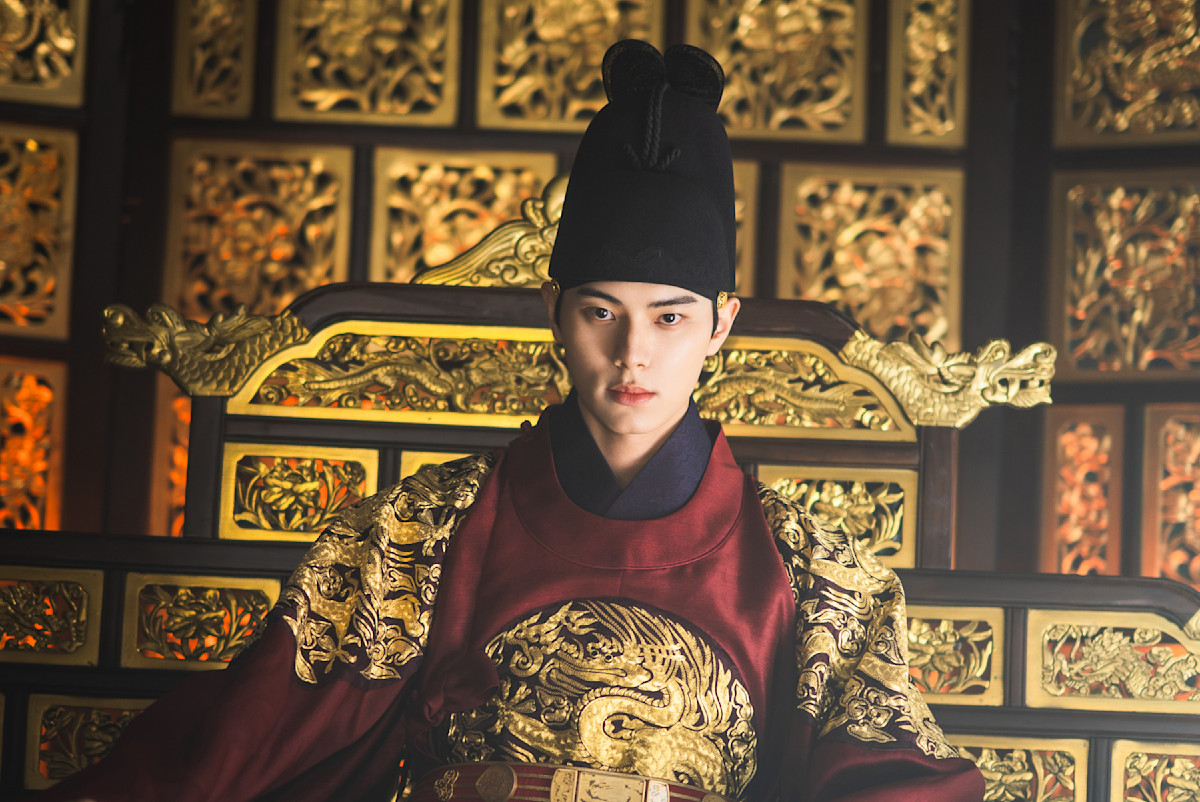“How could a woman know how to prepare a royal meal?” asks a palace cook in Netflix’s “Bon Appetit, Your Majesty.”
Set five hundred years ago during Korea’s Joseon era, the hit period k-drama reveals how courtiers back then only deemed men skilled enough to craft meals worthy of royal consumption. The woman in question, Chef Yeon Ji-yeong (Im Yoon-ah), not only delivers on those high standards but exceeds them, wowing the King (Lee Chae-min) with dishes, ingredients and techniques that haven’t been seen before – literally. It turns out that Chef Yeon is a time-traveling French cuisine chef from the future.
“Bon Appetit, Your Majesty” delights in trotting out Yeon’s modern, European know-how, ranging from whipping up vibrant-hued macarons to maintaining meat’s juiciness through sous vide cooking. However, the limited series similarly introduces viewers – accustomed to kimbap, ramyeon or bulgogi – to unfamiliar historical dishes: Korean palace cuisine.
Junwon Park, who’s training to become a Korean craftsman-level cook, spoke to Salon to highlight this lesser-known fare. Korean palace cuisine, also known as Korean royal court cuisine, is in danger of being lost, which is why Park is gratified to see it depicted in shows popular with global audiences.
“Korean palace cuisine, as the name implies, is the food that kings and queens and the people of the palace ate in the Korean palace,” he said on a Zoom call in early October. “Korean palace cuisine is itself a subset of Korean cuisine, but has its own set of dishes and recipes. But more importantly, I think it’s a culture. And the reason I say that is because, just like in the ‘Bon Appetit, Your Majesty’ show, they used food, not just to eat, but often as a ritualistic event. They were trying to send a message.”
Throughout the series, the palace tasks Chef Yeon with crafting dishes to convey various intangible themes – often with her own life or the country’s future on the line. When instructed to cook a meal “fit for a king,” Yeon turns to venison because deer had symbolized kings, and the tongue is seen as a rare delicacy only he has the privilege to enjoy. Therefore, the thought that goes into the care and feeding of monarchs reaches beyond mere culinary execution but also encompasses ingenuity, knowledge and a sense of diplomacy (not to mention flattery).
“That is just like how it happened in the actual Korean palace,” Park confirmed. “One king, King Yeongjo, actually made a dish called tangpyeong-chae. He made this dish as a cold salad that mixes ingredients of different colors, each color representing a political faction that the palace was divided into. So by serving this dish and announcing the policy of having a quota that his palace is going to hire from all the factions, he was announcing that he wants the palace to be run like that salad – that people from different factions are coming together to create one flavor. So it was not just a dish.”
The thought that goes into the care and feeding of monarchs reaches beyond mere culinary execution but also encompasses ingenuity, knowledge and a sense of diplomacy (not to mention flattery).
Despite her expertise in French cuisine, Chef Yeon also demonstrates a deep understanding of Korean royal cookery and wields her modern knowledge to innovate while still maintaining the integrity of the royal dish. To embody the idea of filial piety to appeal to the Grand Queen Dowager, Yeon creates doenjang-guk, a traditional soybean paste stew, but adds two special ingredients: spinach and clams. She reveals that the spinach – an ingredient not regularly used in cooking during that time period – is full of iron and therefore can help Her Highness, who has been feeling weaker lately.
“Food and medicine share the same roots,” she says, citing the yaksikdongwon philosophy, “If I had to choose, I’d much rather that you stay healthy with delicious food rather than bitter medicine.”
The clams, however, are the stew’s secret weapon. Knowing the Queen Dowager has long sought a doenjang-guk that tastes like her late mother’s, Yeon realizes that clams would add that mystery umami that only people who were raised near the Seomjin River or Nakdong River would have accessed. Once the Queen Dowager tastes the soup, she’s transported back to childhood and tearfully declares, “The soup contains family. She has given me my family through this dish.”
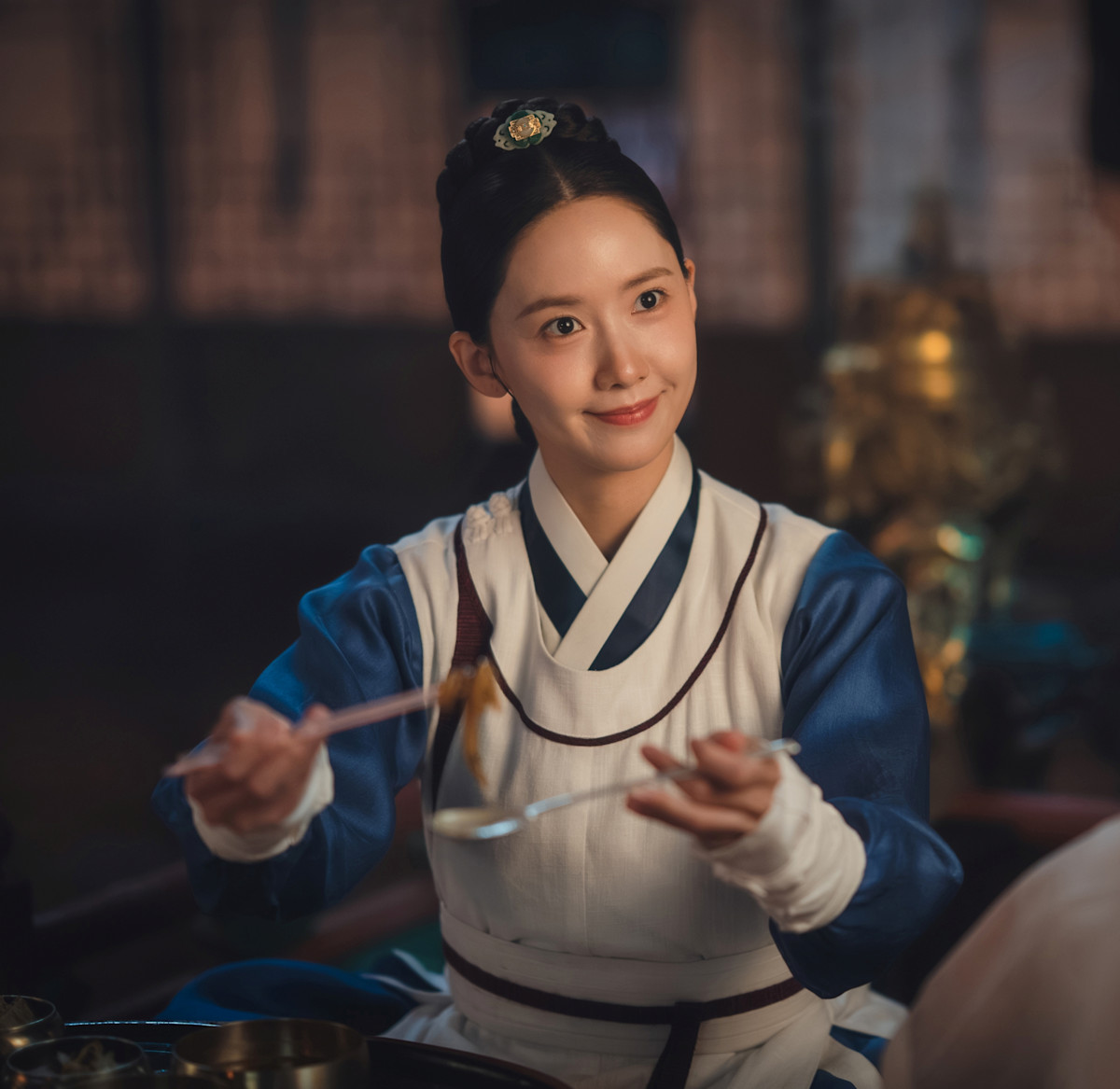
(Netflix) Chef Yeon Ji-yeong (Im Yoon-ah) offers to very respectfully feed the king in “Bon Appetit, Your Majesty”
Later in the series, while prepping the Grand Queen Dowager’s 70th birthday banquet, Chef Yeon must deal with a major menu-planning curveball: the birthday girl has been advised to cut out meat from her diet. Yeon certainly doesn’t want to cook dishes that would threaten the Queen Dowager’s health, especially for an occasion honoring her longevity. But dishes comprising the Korean royal banquet, such as gujeolpan, often include meat. The name gujeolpan refers to nine ingredients on a plate, with eight colorful vegetables or proteins sliced thinly and arrayed around the edge of plate, much like a mouth-watering sundial. Small crepes sit in the dish’s center and provide a wrapper for the ingredients.
“One of the most grand dishes in Korean Palace cuisine is actually what she prepares for the Grand Queen Dowager, which is gujeolpan,” said Park. “Today it’s often used for weddings . . . it’s to show that ‘I am putting in so much effort’ that I’m preparing each ingredient separately, laying it out separately in a beautiful presentation, and then we are putting it together to create one ssam, just like a bossam, or the way that we eat KBBQ in lettuce today. So it has a ritualistic meaning.
“But when [Chef Yeon] prepares it, she prepares a special version of the dish that uses something like Impossible meat, so like a soy-based meat, rather than a regular meat,” he added. The faux meat impresses the courtiers, who note the effort required for the dish.
“Seeing all of you enjoy it so much, I couldn’t ask for more,” says Yeon, before addressing the Grand Queen Dowager, “May you always be safe in good health.”
Korean palace cuisine in the modern era

(Netflix) Hansang food chaebol heir Han Beom-woo (Kang Ha-neul) has a “ratatouille” moment after tasting seopsanjeok in “Tastefully Yours”
These centuries-old royal recipes have also infiltrated media set in the present, such as reality shows like “Culinary Class Wars” and “Chef & My Fridge.” Another Netflix k-drama “Tastefully Yours” in particular highlights the current plight of Korean royal cuisine.
In the limited series, Hansang food conglomerate director Han Beom-woo (Kang Ha-neul) is about to launch his restaurant Motto in the hopes of snagging a three-star rating, but discovers a dish on social media that looks suspiciously like Motto’s signature one. They’re both carefully crafted rectangular stacks of beef with a decorative garnish and sauce artfully streaked across the plate. But after traveling to Jeonju and observing Chef Mo Yeon-joo (Go Min-si) painstakingly source the ingredients and prepare hers, he realizes his error.
“It’s not neobiani but seopsanjeok, you imbecile!” Chef Mo points out to the clueless company heir.
With those words, “Tastefully Yours” highlights the disconnect between everyday eaters and those who actually have a working knowledge of cooking and what ends up on your plate. Park broke down the difference between the two dishes, noting that the flavor profile may be similar to the soy sauce-based seasoning of bulgogi.
“Korean palace cuisine is dying as a cultural heritage.”
“With neobiani, you take a block of meat, slice it thinly, you beat it with the back of the knife to make it very tender, and then you cook it on a grill, like a KBBQ,” he told Salon. “With seopsanjeok, it’s the same sauce, but you mince the meat so that it’s completely taken apart. You mix it with tofu and then you grill it like KBBQ. So the difference is neobiani becomes very chewy because it is still the same slice of meat. With seopsanjeok, even an older person whose teeth are not very strong can still enjoy the same taste, but with the added benefit of tofu as health benefits. So when you eat it, it is a completely different texture and experience.
“So when somebody who knows Korean palace cuisine watches ‘Tastefully Yours,’ this is where you can find out the male protagonist isn’t that interested in food itself,” continued Park. “And the female protagonist laughs, thinking, ‘Oh, you call yourself [an expert] in the food business when you even can’t tell apart these two.'”

(Netflix) Chef Mo Yeon-joo (Go Min-si) regards a mushroom as Han Beom-woo (Kang Ha-neul) prevents her from sliding down the mountainside in “Tastefully Yours”
Chef Mo, who owns a tiny hole-in-the-wall eatery in Jeonju, forages her own mushrooms on the mountainside, grows produce in her backyard and makes most of her laborious, time-intensive dishes from scratch. She takes pride in tailoring the dish to the person or occasion, made with only the proper, seasonal ingredients. Although she doesn’t have a monarch to impress, Mo’s food neverthless conveys her care, respect and sincerity. It’s sustenance infused with storytelling.
Park had a similar awakening to Han Beom-woo’s when it came to discovering Korean palace cuisine on his journey to becoming a Korean craftsman cook.
“In Korea, there are government-certified craftsman cooks of Korea, and every single one of them have to know how to make Korean Palace cuisine,” said Park. “As I was learning, I felt baffled that I didn’t recognize the names of the dishes I was making, like neobiani or seopsanjeok, just like in ‘Tastefully Yours.’ That’s because Koreans who were born and raised in Korea actually don’t know about these, they don’t know the names, they don’t know what they taste like, they don’t know how to make them. And because I was baffled, I looked up why it is that we don’t know about it, and got to find out that Korean palace cuisine is dying as a cultural heritage.”
Reviving royal court cuisine through home cooks
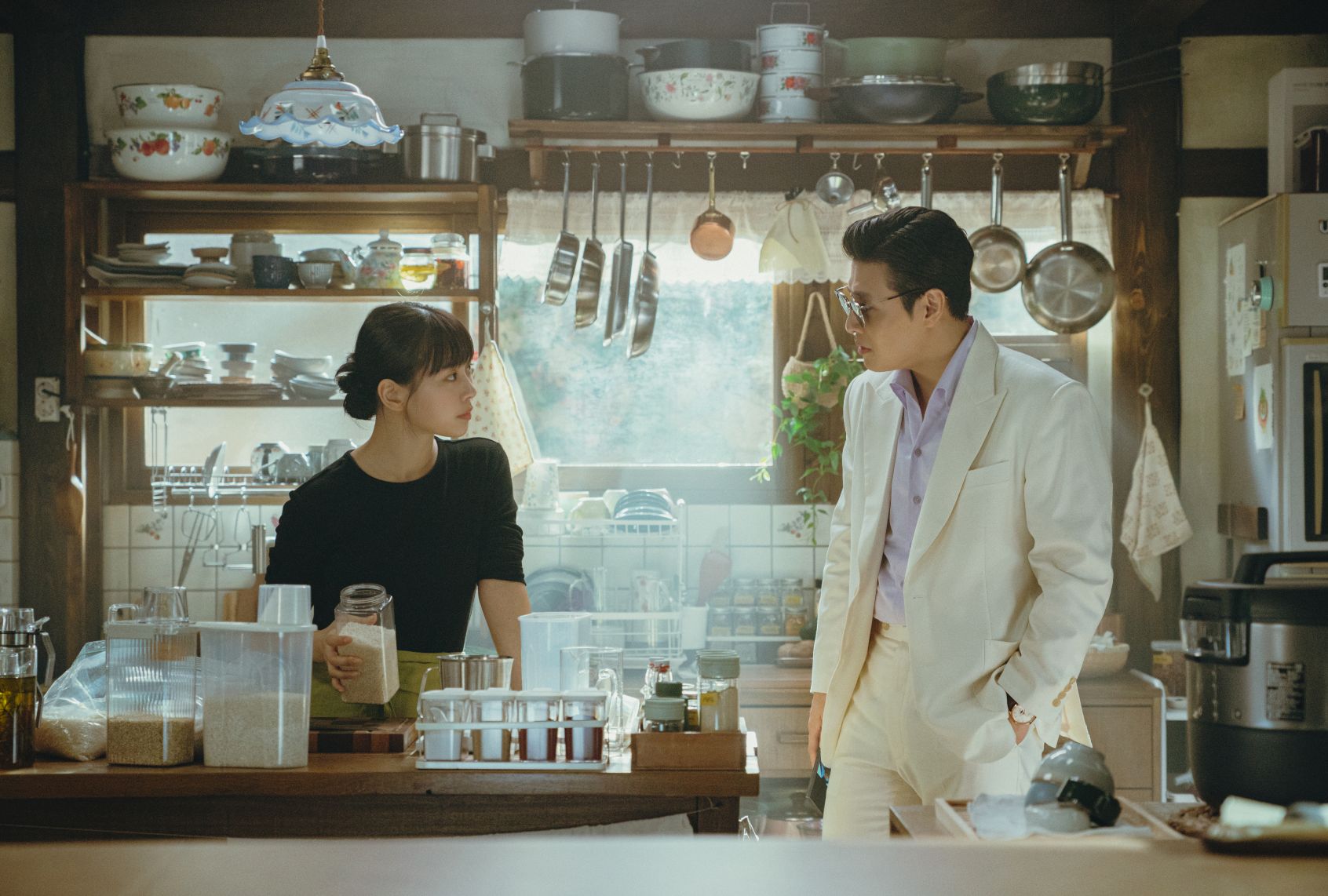
(Netflix) Chef Mo Yeon-joo (Go Min-si) and Han Beom-woo (Kang Ha-neul) in “Tastefully Yours”
Despite Korean palace cuisine appearing on “Bon Appetit, Your Majesty” and other TV shows, these dishes don’t grace everyday dining tables. A certain level of secrecy and gatekeeping had surrounded these recipes over the centuries, which has led to the predicament the cuisine faces today.
Park explained, “Korean palace cuisine was guarded heavily by the Korean palace. The palace maintained a ‘no leaving the door’ policy. The only way to learn or even just taste it was to enter the palace.”
Through record-keeping and the government’s efforts to protect the heritage by instructing craftsman cooks in royal court cuisine, the recipes and practices have survived but aren’t necessarily thriving. In 2011, UNESCO declined to declare Korean royal court cuisine as intangible cultural heritage, a status that has been granted to other food cultures such as the French baguette, beer in Belgium, and even kimjang and its collective practice of making kimchi in Korea. Why then, was Korean palace cuisine rejected?
Although UNESCO acknowledged the efforts by officials and master craftsmen to preserve Korean palace cuisine, the agency noted that there’s no proof of “community participation.” Much like the clueless Han Beom-woo in “Tastefully Yours,” the average person in Korea, even one who may consider themselves a foodie, simply can’t tell the difference between neobiani and seopsanjeok.
“I think UNESCO correctly pointed out that this is not a living culture anymore if it doesn’t have the participation of the people, if it’s practiced only by established authorities like master craftsman cooks and fine dining chefs,” said Park. “If the homes and the people are not cooking it, and if they’re not even eating out [on that cuisine] usually, then how can we call it a culture?”
“A culture is not what a politician, or a CEO, or a pop star says it is. It is what we make happen in our homes.”
This sentiment hit home for Park, whose background is far removed from the elite cookery and fine dining world. Having studied computer science at Stanford and worked on artificial intelligence at Microsoft, Park wasn’t the obvious candidate to pursue craftsman cooking, but he began his culinary student journey as a response to comments from an ex.
“Earlier this year, I actually experienced a breakup, and it wasn’t in reality about cooking, but the surface-level discussion was that it was about cooking,” he confessed. “So cooking to me was more than preparation of food, cooking was a symbol for being dependable; somebody who can cook is somebody who can feed. To become somebody who can be dependable, I wanted to become a cook, but not just somebody who can cook regular food. I wanted to be somebody who can cook really well . . . I wanted to aim for a very high status, which is a government-certified craftsman cook.”
As Park chronicled his journey to craftsman-level cookery on Instagram, he built up a loyal following from around the world that is invested in his progress. During his early days, some even offered up basic tips or advice, such as how to hold a knife properly or how to stabilize the cutting board. Thus, these followers also bore witness to the birth of Park’s second ambitious culinary dream: to convince UNESCO to confer cultural heritage status on Korean palace cuisine. And for that, his platform would be key to making that goal a reality.
“I realized that it is not just about convincing UNESCO. It is actually convincing the home cooks that culture is not something we can leave to the government or authorities like master craftsman cooks to save it,” he said. “Only home cooks have the power to create cultures and keep cultures alive. A culture is not what a politician, or a CEO, or a pop star says it is. It is what we make happen in our homes.”
On his website Junwon.com, Park encourages his global following to sign a petition to save Korean palace cuisine but to also cook the recipes he posts and upload photos or videos as proof of their own efforts, thus demonstrating the culture is alive in their kitchens. None of the recipes are overly challenging either, and in fact, many of them are simple and range from banchan (side dishes) and soups to main entrees.
It turns out that despite the name, Korean royal court cuisine isn’t elaborate or fussy, but rather accessible to anyone. “Bon Appetit, Your Majesty” drives home that what counts is not only the consideration put into the composition of a meal, but also how well the cook can bring out the true flavors of the ingredients rather than transform or disguise them.
“I’m not one of those elite cooks; I’m more relatable in that everybody saw me start off as a way worse cook than they were,” added Park. “If I can cook a Korean palace cuisine dish, anybody watching my videos can cook a Korean palace cuisine dish.”
Japchae is one of the dishes from the Korean palace cuisine repertoire that remains a part of the regular diet of Koreans today and has actually become familiar enough to foreigners that Trader Joe’s in the United States sells a version in its freezer section. Featuring vegetables and cellophane noodles made from sweet potatoes and flavored with sesame oil and soy sauce, japchae is mild yet savory in flavor, untouched by the vibrant red of the chili that is often featured in today’s Korean fare.
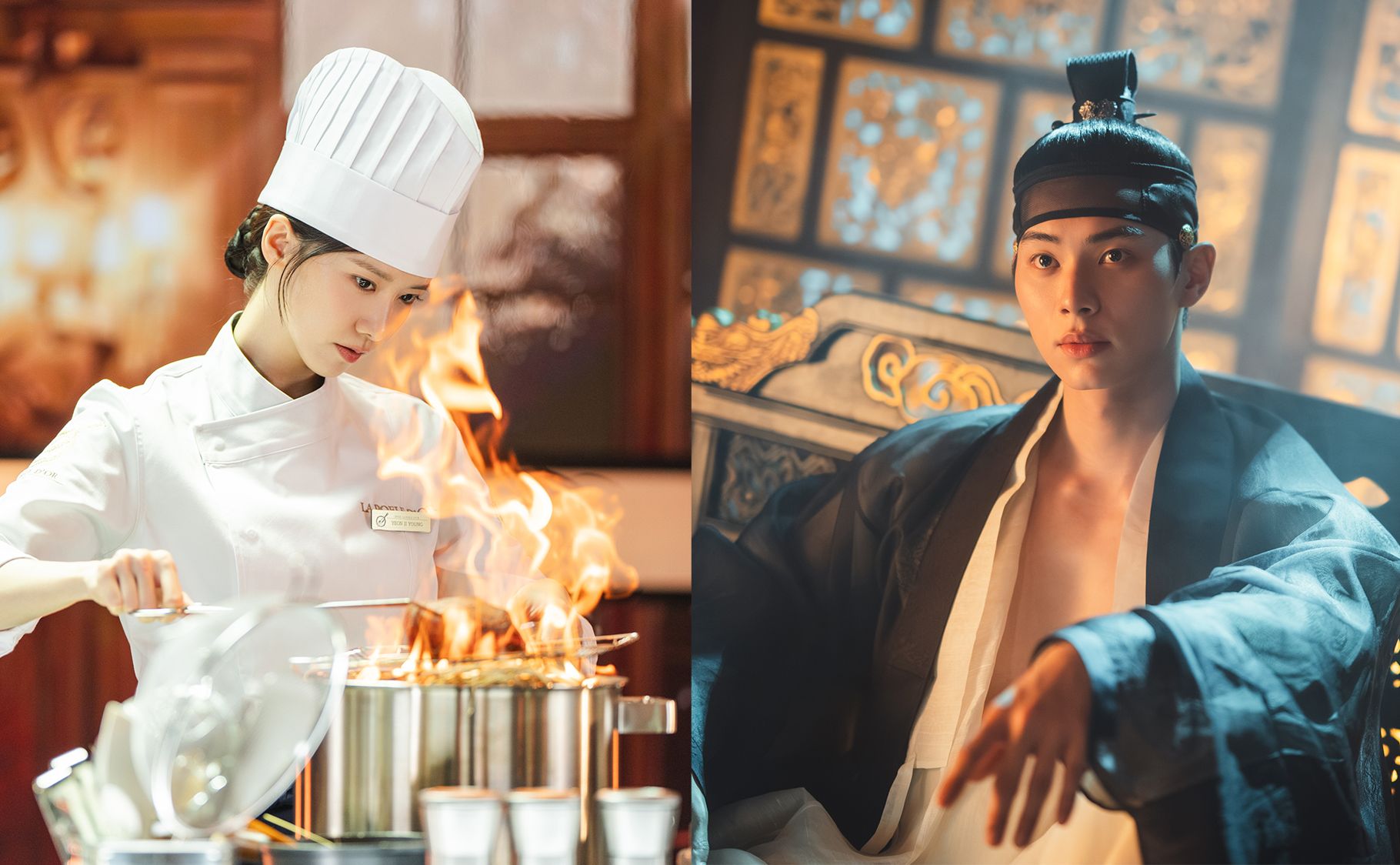
(Netflix) Im Yoon-ah as Chef Yeon Ji-yeong and Lee Chae-min as the tyrant foodie king in “Bon Appetit, Your Majesty”
“Japchae and galbijjim are two examples that maintain the recipes as they were. So when people are eating galbijjim or japchae, they actually are tasting [a dish] more or less the way that the kings and queens tasted back then,” said Park. So one thing that you can find out about Korean Palace cuisine by eating japchae or galbijjim is that they’re not spicy and they’re not red-colored.
“What I think ‘Bon Appetit, Your Majesty’ did a fantastic job of showing in the first episode is where they show that the king is shocked to find that bibimbap has gochujang [an ingredient Chef Yeon had retained from the future],” Park continued. “The idea of a spicy flavor is just so crazy [to him]. Korean palace cuisine dishes usually don’t rely on sauces for flavoring. They rely on bringing out the flavors of the ingredients. And even when they’re using those sauces, they try to use soy sauce and sesame oil with a little bit of flavoring oil, rather than going for a more domineering spicy flavor.”
This is also why when Chef Yeon serves tteokbokki, a popular dish of chewy cylinder-shaped rice cakes, it’s not the spicy version popular now, but one flavored with soy sauce. This is why that milder version is known as royal court tteokbokki.
The power of the people
As of the writing of this story, the petition has gained more than 11,000 signatures. Park has been gratified to see just how far his Korean palace cuisine mission has reached.
“Just yesterday, somebody from Guatemala [posted that they had] cooked janggukjuk, which I think is an excellent dish to make,” he said. “Janggukjuk is a porridge dish that uses beef and pyogo mushroom, which is also sold as shiitake mushroom, and flavored with soy sauce. So it’s an excellent dish to know, especially for when you or somebody you know is feeling under the weather, because a porridge with that much nutrition is going to uplift them real quick.”
While a good majority of the signatures have hailed from the U.S., Park notes that the international following has been growing rapidly over the last few weeks.
“It started off as over 90% of United States, when I was also in the United States,” he said. “But after I came here [to Korea], countries from Southeast Asia, especially Indonesia and Vietnam, have shown a lot of support. Countries in Europe and South America, North America as well, have shown up. And some cultures that surprised me are people from Middle East and Africa that use translators to message me on top of signing their signatures. So those have been very surprising to me in how much they love Korean culture and are willing to help out.”
“Homemakers are the true guardians of cultures.”
Of course, these recipes still exist today because of others who also believed that Korean royal court cuisine should belong to the people and not die out with the monarchy. In “Bon Appetit, Your Majesty,” Chef Yeon’s prized possession is an ancient record book of dishes the palace served, along with descriptions and illustrations.
“Palace kitchen cooks passed [these recipes] on to disciples after Korea transitioned to democracy,” said Park. “Also, the Korean palace was obsessed with record-keeping. The sillok [records of the Joseon dynasty], which is mentioned in ‘Bon Appetit, Your Majesty,’ recorded everything that happened in the palace, and uigwe [Joseon dynasty records of rituals and ceremonies] recorded festivals such as the Grand Queen Dowager’s birthday party in the drama. The ancestors thankfully wrote down what they ate along with details like which ingredients went into the dishes.”
In addition, Park added that today, “Master craftsman cooks are also teaching students on top of cooking on their own. “For example, Master Craftsman Cook Han Bok-ryeo taught Chef Son Jong-won who appears on ‘Chef & My Fridge’ and Chef Leo Kang who was the judge at ‘MasterChef Korea,’ said Park. “Students become great cooks, and carry on the legacy either as is, or in combination with modern techniques as did Chef Yeon in the show.”
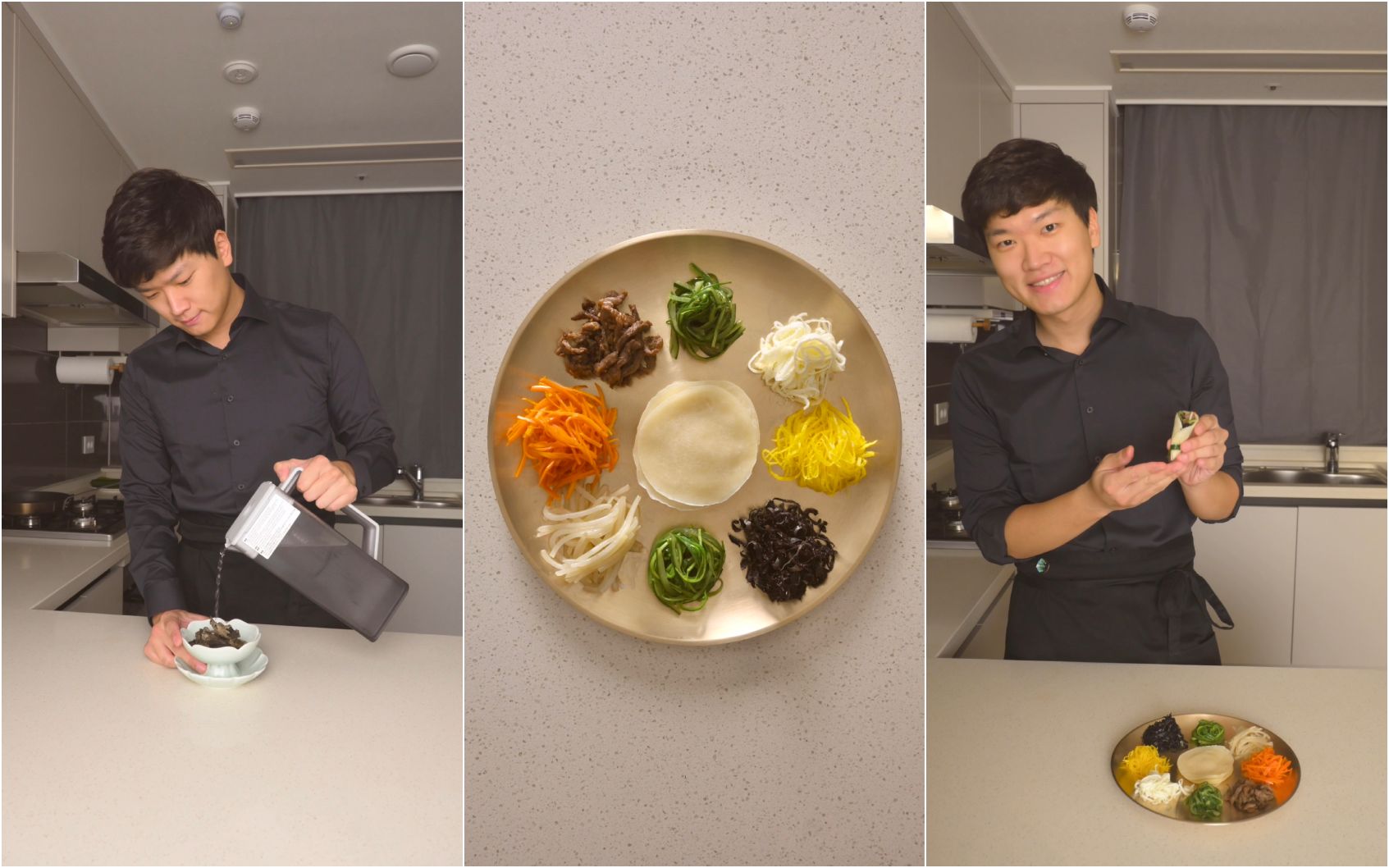
(Junwon Park) Junwon Park prepares, displays and then shows how to eat gujeolpan – a colorful dish of meat and vegetables eaten in a simple crepe wrap.
Park joins this tradition as a link in the chain of sharing knowledge. On “Culinary Class Wars,” Chef Ahn You-seong – who’s also Korea’s 16th presidential culinary Master Hand – participated as one of the elite White Spoon chefs. Park is the new student of Chef Ahn’s teacher, Master Heo Yi-jae, and is now passing along the recipes to his followers.
As for the petition to save Korean palace cuisine, Park wants to amass 33,000 signatures, the same number of people the French government cited as proof of participating in baguette-making. He has also set a deadline to reach this number in late November, aiming for the anniversary of when UNESCO rejected Korean palace cuisine as cultural heritage in the first place. At that point, he’ll send the petition to the Korean government’s Ministry of Culture to then resubmit to UNESCO.
“Yes, 33,000 is a big number, but it’s not an impossible number,” he said. “We already got thousands of people and with people who read this article and choose to care about it instead of just passing on, then we can reach 33,000. I have faith that we can make it. Homemakers are the true guardians of cultures. I’m on a quest to make homemakers realize their power, because only if they realize their true power and choose to use their power, Korean palace cuisine can be saved.”
In the meantime, Park is celebrating a milestone in his culinary instruction journey, having finally delivered a dish that meets Master Heo’s exacting standards.
“When I’m learning with her, the things I learn are more than just flavors,” he said. “If I’m cutting something to 3 millimeters of depth, when I should be using 2 millimeters of depth, she would see it and tell me that this is not craftsman-level. Gujeolpan is actually the first dish that I got recognition from my teacher that this is craftsman-level cooking.” It seems that gujeolpan, the dish that Chef Yeon made for the Grand Queen Dowager, is cause for celebration once again.
Park’s culinary odyssey began with knife in hand to take control of his own story, which resonated with followers worldwide. Now, by embracing palace cuisine through Korean dramas and making the recipes themselves, these same followers are able to embrace a similar intentionality to flex their power through food. Each new dish made adds to the far-reaching, collective storytelling of this project that ties to the past – and no magical book or time slip was needed.
Sign the petition to save Korean palace cuisine at Junwon.com. “Bon Appetit, Your Majesty,” “Tastefully Yours” and “Culinary Class Wars” are available to stream on Netflix.
Read more
about Korean and Korean American culture
- The “Squid Game” critique is also a love letter to a unified Korea
- “KPop Demon Hunters”: Jinu’s seriously derpy tiger origin story
- (Not) made in America: 6 Korean shows and their remade U.S. counterparts
- “Connected through inyeon”: Teo Yoo reflects on the fate that guided his career and to “Past Lives”
